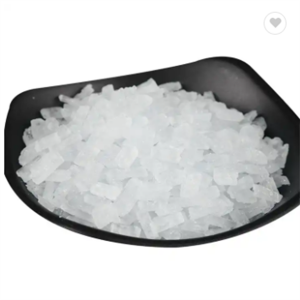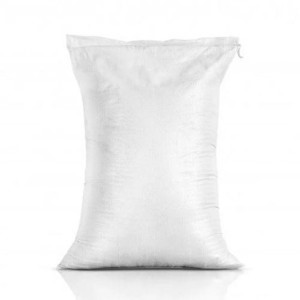Sodium persulfate, also known as sodium persulfate, is an inorganic compound, the chemical formula Na2S2O8, is a white crystalline powder, soluble in water, insoluble in ethanol, mainly used as bleach, oxidant, emulsion polymerization accelerator.
Properties: White crystal or crystalline powder. No smell. Tasteless. Molecular formula Na2S2O8, molecular weight 238.13. It is gradually decomposed at room temperature, and can be rapidly decomposed by heating or in ethanol, after which oxygen is released and sodium pyrosulfate is formed. Moisture and platinum black, silver, lead, iron, copper, magnesium, nickel, manganese and other metal ions or their alloys can promote decomposition, high temperature (about 200℃) rapid decomposition, release hydrogen peroxide. Soluble in water (70.4 at 20℃). It is highly oxidizing. Strong irritation to the skin, long-term contact with the skin, can cause allergies, should pay attention to the operation. Rat transoral LD50895mg/kg. Store tightly. The laboratory produces sodium persulfate by heating a solution of ammonium persulfate with caustic soda or sodium carbonate to remove ammonia and carbon dioxide.
Strong oxidizing agent: Sodium persulfate has strong oxidation, can be used as an oxidizing agent, can oxidize Cr3+, Mn2+, etc. into the corresponding high oxidation state compounds, when there is Ag+, can promote the above oxidation reaction; It can be used as bleaching agent, metal surface treatment agent and chemical reagent by its oxidation property. Pharmaceutical raw materials; Accelerators and initiators for battery and emulsion polymerization reactions.
Application:Sodium persulfate finds extensive use as a bleach, oxidant, and emulsion polymerization accelerator. Its ability to remove stains and whiten fabrics has earned it a renowned reputation as a bleaching agent. Whether it’s stubborn wine stains on your favorite shirt or discolored linens, sodium persulfate can effortlessly tackle these issues.
Furthermore, sodium persulfate showcases potent oxidizing properties. This makes it ideal for aiding in chemical reactions that require the removal of electrons. In industries that rely heavily on oxidation processes, such as the production of pharmaceuticals and dyes, sodium persulfate proves to be an invaluable asset.
Additionally, this compound also serves as an emulsion polymerization promoter. For those unfamiliar with the term, emulsion polymerization refers to the process of synthesizing polymers in an aqueous medium. Sodium persulfate acts as a catalyst, assisting in the formation of these polymers. Industries utilizing emulsion polymerization, such as adhesives and coatings, heavily rely on sodium persulfate for its effectiveness in achieving desired outcomes.
The multifaceted nature of sodium persulfate is what sets it apart from other compounds. Its ability to function as both a bleaching agent and an oxidant makes it an attractive option for a wide range of industries. Additionally, its emulsion polymerization promoting properties further broaden its scope of application.
Besides its varied uses, sodium persulfate boasts several other distinguishing features. Its water solubility enhances its efficacy as a bleach and oxidant, allowing it to readily dissolve and interact with other substances. On the other hand, its insolubility in ethanol prevents it from interfering with processes that rely on ethanol as a solvent.
To ensure optimal usage of sodium persulfate, it is imperative to consider certain factors. Careful handling and adherence to safety guidelines are essential due to its potentially hazardous nature. Furthermore, appropriate dosage is crucial when incorporating sodium persulfate into any process, be it bleaching, oxidation, or emulsion polymerization.
Package:25kg/Bag
Operation precautions: closed operation, strengthen ventilation. Operators must be specially trained and strictly abide by the operating procedures. It is recommended that operators wear a headcover-type electric air supply filter dust-proof respirator, polyethylene protective clothing, and rubber gloves. Keep away from fire and heat. No smoking in the workplace. Avoid producing dust. Avoid contact with reducing agents, active metal powders, alkalis, alcohols. When handling, light loading and unloading should be done to prevent damage to packaging and containers. Do not shock, impact and friction. Equipped with the corresponding variety and quantity of fire equipment and leakage emergency treatment equipment. Empty containers may have harmful residues.
Storage precautions: Store in a cool, dry and well-ventilated warehouse. Keep away from fire and heat. The temperature of the reservoir shall not exceed 30℃, and the relative humidity shall not exceed 80%. The package is sealed. It should be stored separately from reducing agents, active metal powders, alkalis, alcohols, etc., and should not be mixed. Storage areas should be equipped with suitable materials to contain leaks.
In conclusion, sodium persulfate remains a versatile and indispensable compound. Its efficacy as a bleach, oxidant, and emulsion polymerization promoter places it in high demand. With its chemical formula Na2S2O8, this white crystalline powder continues to serve a vital role across various industries. As with any chemical compound, it is essential to handle sodium persulfate with care and be mindful of the proper dosage. So, the next time you find yourself in need of a reliable bleach or oxidant, consider reaching for sodium persulfate, the powerhouse compound that never fails to deliver exceptional results.
Post time: Jun-26-2023








